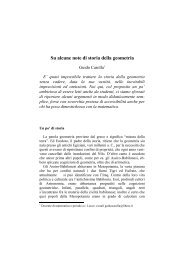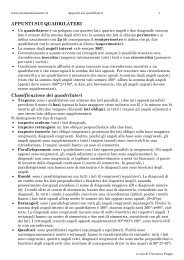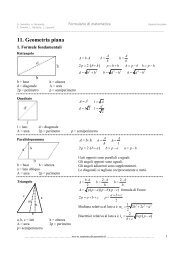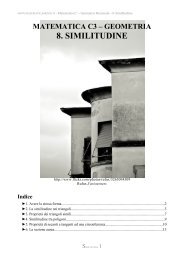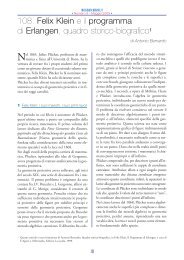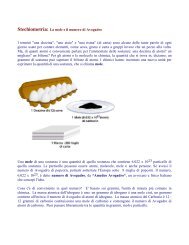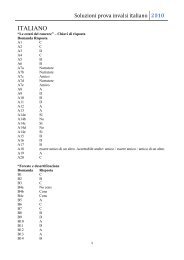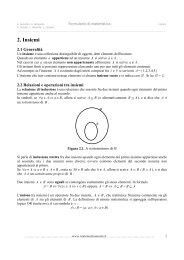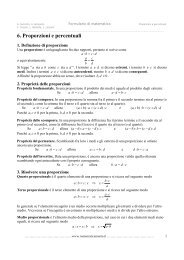Scarica la tesi Integrale di Feynman sui Cammini e Processi Stocastici
Scarica la tesi Integrale di Feynman sui Cammini e Processi Stocastici
Scarica la tesi Integrale di Feynman sui Cammini e Processi Stocastici
You also want an ePaper? Increase the reach of your titles
YUMPU automatically turns print PDFs into web optimized ePapers that Google loves.
0.1 Introduzione<br />
In questo <strong>la</strong>voro si presenta ed e<strong>la</strong>bora concettualmente <strong>la</strong> Formu<strong>la</strong>zione <strong>di</strong> <strong>Feynman</strong><br />
del<strong>la</strong> Meccanica Quantistica (MQ), i problemi <strong>di</strong> convergenza dell’integrale<br />
<strong>sui</strong> cammini e <strong>la</strong> re<strong>la</strong>zione <strong>di</strong> questa formu<strong>la</strong>zione con i processi stocastici. Dapprima,<br />
nel<strong>la</strong> sezione {0.2}, viene derivato l’integrale <strong>sui</strong> cammini <strong>di</strong> <strong>Feynman</strong><br />
attraverso l’utilizzo del<strong>la</strong> formu<strong>la</strong> <strong>di</strong> Trotter e successivamente, nel<strong>la</strong> sezione<br />
{0.3}, sono presentati i postu<strong>la</strong>ti del<strong>la</strong> formu<strong>la</strong>zione <strong>di</strong> <strong>Feynman</strong> del<strong>la</strong> MQ. Sono<br />
poi stu<strong>di</strong>ati i cammini <strong>di</strong> <strong>Feynman</strong> e le loro caratteristiche peculiari, che offrono<br />
uno stretto paragone con i processi stocastici. Nelle sezioni {0.7},{0.8} vengono<br />
prima mostrate le problematiche <strong>di</strong> convergenza dell’integrale <strong>di</strong> <strong>Feynman</strong> e poi,<br />
seguendo <strong>la</strong> <strong>di</strong>mostrazione <strong>di</strong> Nelson del teorema <strong>di</strong> Kolmogorov, l’approccio <strong>di</strong><br />
Kac che permette <strong>di</strong> definire rigorosamente una misura per l’integrale: <strong>la</strong> misura<br />
<strong>di</strong> Wiener. Nel<strong>la</strong> sezione {0.9} è mostrata l’equazione del calore e <strong>la</strong> sua stretta<br />
re<strong>la</strong>zione con il moto browniano, esempio più semplice <strong>di</strong> processo stocastico.<br />
Ciò ci permette, nelle due sezioni successive, <strong>di</strong> paragonare <strong>di</strong>rettamente prima<br />
l’integrale <strong>di</strong> <strong>Feynman</strong> con quello <strong>di</strong> Wiener e poi l’equazione <strong>di</strong> Schrö<strong>di</strong>nger<br />
con quel<strong>la</strong> <strong>di</strong> Fokker-P<strong>la</strong>nk. Da questo confronto si conclude che l’evoluzione<br />
temporale <strong>di</strong> una particel<strong>la</strong> quantistica può essere descritta come un’evoluzione<br />
deterministica perturbata da fluttuazioni quantistiche.<br />
0.2 Derivazione dell’<strong>Integrale</strong> <strong>sui</strong> <strong>Cammini</strong> <strong>di</strong><br />
<strong>Feynman</strong> attraverso <strong>la</strong> Formu<strong>la</strong> <strong>di</strong> Trotter.<br />
Consideriamo inizialmente l’equazione <strong>di</strong> Schrö<strong>di</strong>nger <strong>di</strong> una particel<strong>la</strong> non<br />
re<strong>la</strong>tivistica in moto uni<strong>di</strong>mensionale in presenza <strong>di</strong> un potenziale sca<strong>la</strong>re V (x):<br />
i¯h ∂<br />
¯h2<br />
ψ(x, t) = −<br />
∂t 2m<br />
∂ 2<br />
ψ(x, t) + V (x)ψ(x, t) (1)<br />
∂x2 Un’arbitraria soluzione <strong>di</strong> tale equazione, in<strong>di</strong>viduata dal<strong>la</strong> con<strong>di</strong>zione iniziale<br />
ψ(x0, t0), può essere scritta attraverso <strong>la</strong> Funzione <strong>di</strong> Green o anche detta in<br />
meccanica quantistica propagatore 〈x, t|x0, t0〉 1 :<br />
ψ(x, t) =<br />
+∞<br />
−∞<br />
dx0〈x, t|x0, t0〉ψ(x0, t0) (2)<br />
Il termine propagatore in<strong>di</strong>ca il significato fisico <strong>di</strong> tale funzione; infatti essa<br />
rappresenta l’ampiezza <strong>di</strong> probabilità <strong>di</strong> passare da x0 all’istante t0 a x all’istante<br />
t, cioè da (x0, t0) a (x, t). L’importanza del propagatore e dell’approccio<br />
<strong>di</strong> <strong>Feynman</strong> è che tale oggetto matematico permette <strong>di</strong> calco<strong>la</strong>re un’arbitraria<br />
soluzione dell’equazione <strong>di</strong> Schrö<strong>di</strong>nger, senza dover risolvere esplicitamente <strong>la</strong><br />
(1).<br />
Ciò che faremo ora è indagare <strong>la</strong> natura <strong>di</strong> tale propagatore; otterremo così<br />
l’integrale <strong>di</strong> <strong>Feynman</strong>. Sia H l’operatore hamiltoniana e assumiamo H = T + V ,<br />
dove T rappresenta l’operatore energia cinetica e V quello energia potenziale.<br />
Fissiamo l’attenzione sul propagatore 〈x ′′ , t ′′ |x ′ , t ′ 〉 dallo stato (x ′ , t ′ ) a (x ′′ , t ′′ ).<br />
1 In questo e<strong>la</strong>borato successivamente il propagatore verrà in<strong>di</strong>cato anche con G(x, x0; t, t0).<br />
Si ha che G(x, x0; t0, t0) = δ(x − x0), come è facile da verificare.<br />
1





